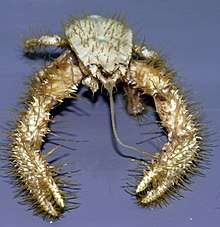Kiwa hirsuta
Kiwa hirsuta is a crustacean discovered in 2005 in the South Pacific Ocean.[1] This decapod, which is approximately 15 cm (5.9 in) long, is notable for the quantity of silky blond setae (resembling fur) covering its pereiopods (thoracic legs, including claws). Its discoverers dubbed it the "yeti lobster" or "yeti crab".[2]
| Kiwa hirsuta | |
|---|---|
 | |
| Scientific classification | |
| Kingdom: | |
| Phylum: | |
| Subphylum: | |
| Class: | |
| Order: | |
| Infraorder: | |
| Family: | |
| Genus: | Kiwa |
| Species: | K. hirsuta |
| Binomial name | |
| Kiwa hirsuta Macpherson, Jones & Segonzac, 2006 | |
Identification
K. hirsuta was discovered in March 2005 by a group organized by Robert Vrijenhoek of the Monterey Bay Aquarium Research Institute in Monterey, California and Michel Segonzac of the Ifremer and a Census of Marine Life scientist using the submarine DSV Alvin, operating from RV Atlantis.[3] The discovery was announced on 7 March 2006. It was found along the Pacific-Antarctic Ridge, 1,500 kilometres (930 mi) south of Easter Island at a depth of 2,200 metres (7,200 ft), living on hydrothermal vents.[1] Based on both morphology and molecular data, the organism was deemed to form a new biological family (Kiwaidae);[4] a second species, Kiwa puravida, was discovered in 2006 and described in 2011.[5] Yeti Crabs live in the deep oceans, in hydrothermal vents, which are deep within the ocean. These vents provide hot water which makes up the environment of where these crabs live.
Characteristics
The animal has strongly reduced eyes that lack pigment, and is thought to be blind. The "hairy" pincers contain filamentous bacteria, which the creature may use to detoxify poisonous minerals from the water emitted by the hydrothermal vents where it lives. This process is known as chemosynthesis. Lipid and isotope analyses provide evidence that epibiotic bacteria are the crab's main food source and K. puravida n. sp. has highly-modified setae (hairs) on its 3rd maxilliped (a mouth appendage) which it uses to harvest these bacteria. The ε- and γ- proteobacteria that this methane-seep species farms are closely related to hydrothermal-vent decapod epibionts.[6] Alternatively, it may feed on bacteria, although it is generally thought to be a carnivore.[2]
Although it is often referred to as the "furry lobster" outside the scientific literature,[2] Kiwa hirsuta is a squat lobster,[1] more closely related to crabs and hermit crabs than true lobsters. The term "furry lobster" is more commonly used for the family Synaxidae.[7]
Etymology
Macpherson et al. named the genus Kiwa after "the goddess of the shellfish in the Polynesian mythology", although "Kiwa" is a male guardian of the sea in Māori mythology.[8] Hirsuta is Latin for "hairy".
Further reading
- Goffredi, Shana K.; Jones, William J.; Erhich, Hermann; Springer, Armin; Vrijenhoek, Robert C. (2008). "Epibiotic bacteria associated with the recently discovered yeti crab, Kiwa hirsuta". Environmental Microbiology. 10 (10): 2623–2634. doi:10.1111/j.1462-2920.2008.01684.x. PMID 18564185.
- C. N. Roterman, J. T. Copley, K. T. Linse, P. A. Tyler & A. D. Rogers (2013). "The biogeography of the yeti crabs (Kiwaidae) with notes on the phylogeny of the Chirostyloidea (Decapoda: Anomura)". Proceedings of the Royal Society B: Biological Sciences. 280 (1764): 20130718. doi:10.1098/rspb.2013.0718. PMC 3712414. PMID 23782878.CS1 maint: uses authors parameter (link)
References
- E. Macpherson, W. Jones & M. Segonzac (2006). "A new squat lobster family of Galatheoidea (Crustacea, Decapoda, Anomura) from the hydrothermal vents of the Pacific–Antarctic Ridge" (PDF). Zoosystema. 27 (4): 709–723.
- "'Furry lobster' found in Pacific". BBC News. March 8, 2006.
- "Easter Microplate Expedition March 12–April 6, 2005". Monterey Bay Aquarium Research Institute.
- Cornelia Dean (March 14, 2006). "In the deep, deep sea, the 'yeti crab'". New York Times. Retrieved December 6, 2010.
- Andrew R. Thurber, William J. Jones & Kareen Schnabel (2011). "Dancing for food in the deep sea: bacterial farming by a new species of yeti crab". PLOS ONE. 6 (11): e26243. Bibcode:2011PLoSO...626243T. doi:10.1371/journal.pone.0026243. PMC 3227565. PMID 22140426.
- Thurber Andrew R (2011). "Dancing for Food in the Deep Sea: Bacterial Farming by a New Species of Yeti Crab". PLOS One. 6 (11): e26243. Bibcode:2011PLoSO...626243T. doi:10.1371/journal.pone.0026243. PMC 3227565. PMID 22140426.
- Thurber, Andrew R. (November 30, 2011). "Dancing for Food in the Deep Sea: Bacterial Farming by a New Species of Yeti Crab". PLOS ONE. 6 (11): e26243. Bibcode:2011PLoSO...626243T. CiteSeerX 10.1.1.288.5286. doi:10.1371/journal.pone.0026243. PMC 3227565. PMID 22140426.
- Elsdon Best (1924). "IV. Cosmogony and Anthropogeny". The Maori - Volume 1. pp. 89–105.
External links
